




Medicare Advantage Plans South Dakota 2026
Curious about the potential Medicare Advantage Plans in South Dakota for 2026? This article covers the available plan options, potential benefits, and the enrollment process. Get a detailed look into what you need to know for making informed decisions.
Key Takeaways
- South Dakota Medicare Advantage Plans provide comprehensive coverage, including hospital and medical insurance, sometimes including bundled with additional benefits like dental, hearing, and vision care.
- A variety of plans are available, including HMOs, PPOs, and Special Needs Plans (SNPs), each designed to cater to different healthcare needs and access challenges, particularly in rural areas.
- The enrollment process is straightforward, with multiple options available, and it is essential for prospective enrollees to prepare the necessary documentation to ensure a smooth experience.
Compare Plans in One Step!
Enter Zip Code
Understanding South Dakota Medicare Advantage Plans 2026

Medicare Advantage Plans, also known as Medicare Part C, could act as an alternative to Original Medicare, offering a bundled plan that includes Part A (hospital insurance) and Part B (medical insurance). These plans are managed by private insurance companies, which will likely set their own coverage and costs. In South Dakota, the Medicare Advantage plans will likely be tailored to meet the diverse needs of its residents, possibly ensuring comprehensive healthcare coverage.
One of the potential advantages of Medicare Advantage Plans in South Dakota might be the involvement of provider-led health plans and provider led health plans. These plans will likely be managed by local healthcare organizations, which might offer robust network and comprehensive coverage options. These providers could help ensure that the coverage is aligned with the core health plan operations, possibly offering high-value care to the beneficiaries.
South Dakota’s Medicare Advantage Plans will likely be designed to cater to both urban and rural populations. This could be particularly important in a state where rural healthcare access might be a challenge. By working collaboratively with local providers and nonprofit health systems, these plans could help ensure that even the most remote communities have access to essential healthcare services.
Types of South Dakota Medicare Advantage Plans Available
South Dakota offers a diverse range of Medicare Advantage Plans to cater to different healthcare needs. These plans include:
- Health Maintenance Organizations (HMO)
- Preferred Provider Organizations (PPO)
- Private Fee-for-Service (PFFS)
- Special Needs Plans (SNPs)
Each type of plan offers distinct benefits and coverage options, possibly ensuring that residents can find a plan that best suits their needs.
HMO Plans
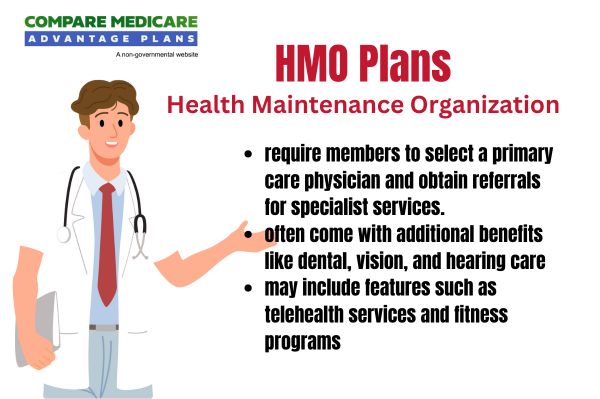
Health Maintenance Organization (HMO) plans require members to choose a primary care physician (PCP) who will coordinate all their healthcare needs. This means that for most specialist services, members might need a referral from their PCP. One potential advantage of HMO plans may be the potential reduction of premiums and out-of-pocket costs, which could make them an economical choice for many.
In South Dakota, HMO plans will likely be designed to use a network of local doctors and hospitals for covered services, except in emergencies. This network-centric approach could help ensure that care is provided by trusted local providers, which could be particularly beneficial in rural areas.
PPO Plans
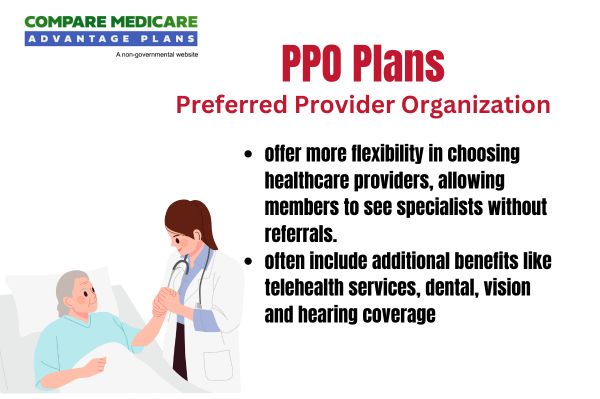
Preferred Provider Organization (PPO) plans offer greater flexibility compared to HMOs. Members can see any doctor or specialist without needing a referral, which could be a significant advantage for those who prefer more freedom in their healthcare choices. PPO plans also allow members to visit out-of-network providers, although at a higher cost than in-network services.
Some PPO plans may go beyond basic coverage by including additional benefits such as vision and dental care. These plans may also come with higher monthly premiums, but the added flexibility will likely make them a worthwhile investment. Various PPO plans in the state have also achieved high satisfaction ratings, reflecting the value they offer to enrollees.
Special Needs Plans (SNPs)
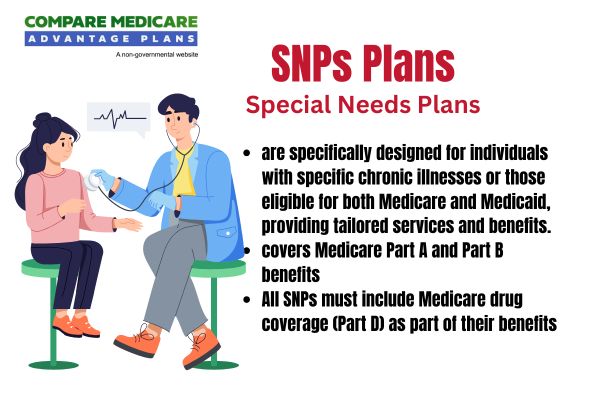
Special Needs Plans (SNPs) are tailored for individuals with specific health conditions or circumstances. These plans could offer specialized care and services that address the unique needs of their members.
To enroll in a Dual Complete SNP, individuals must be eligible for both Medicare and Medicaid. These plans combine Medicare Parts A and B, providing a comprehensive package that addresses the full spectrum of healthcare needs.
UnitedHealthcare will likely be one of the providers offering various SNPs in South Dakota, likely ensuring that those with chronic conditions or disabilities could receive the care they need.
Overview of South Dakota Medicare Advantage Plans 2026
Some Medicare Advantage Plans in South Dakota may offer a robust alternative to Original Medicare, which may include additional benefits. These plans are administered by private insurance companies, which means the plans might offer varied coverage options and set their own costs.
Possible Services and Benefits

Medicare Advantage Plans in South Dakota typically include coverage for hospital (Part A) and medical insurance (Part B), combining the benefits of Original Medicare into a single plan. Additionally, certain plans may also offer prescription drug coverage (Part D), which could be a significant advantage for those who need regular medications. This potential integration could simplify healthcare management for beneficiaries. Beyond the standard Medicare benefits, some plans may also include additional services such as dental, vision, and hearing care.
Enrollment Process for South Dakota Medicare Advantage Plans 2026
Enrolling in a Medicare Advantage Plan in South Dakota involves a few steps. Eligible individuals can choose from a variety of plans managed by private insurance companies, which will likely set their own benefits and costs. The enrollment process is designed to be straightforward, ensuring that beneficiaries can easily find and enroll in a plan that meets their needs.
The initial step is to determine eligibility. To qualify for a Medicare Advantage Plan, individuals must first be enrolled in Original Medicare (Parts A and B). They must also live within the service area of the plan they wish to join. Once eligibility is confirmed, the next step is to choose a plan that offers the desired coverage and benefits.
When to Enroll
The enrollment period for Medicare Advantage Plans is crucial to ensure continuous coverage. Eligible individuals can enroll during a 7-month window that spans three months before, the month of, and three months after their 65th birthday. This Initial Enrollment Period (IEP) is the first opportunity for new beneficiaries to join a Medicare Advantage Plan.
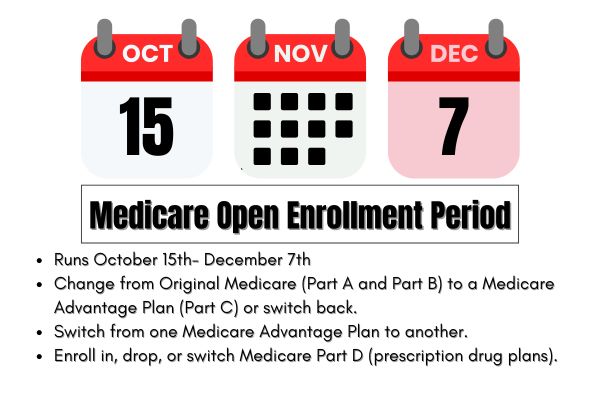
Additionally, there are specific enrollment periods each year, such as the General Enrollment Period (GEP) from January 1 to March 31 and the Open Enrollment Period (OEP) from October 15 to December 7. These periods allow individuals to switch plans or make changes to their existing coverage.
Different Enrollment Periods
Understanding the various enrollment periods is essential for managing Medicare Advantage coverage. The Initial Enrollment Period (IEP) is the first opportunity for eligible individuals to enroll in Medicare Advantage. This period lasts for seven months, starting three months before an individual turns 65 and ending three months after.
The Open Enrollment Period (OEP) runs from October 15 to December 7 each year, allowing beneficiaries to join, switch, or drop their Medicare Advantage Plans. Additionally, the Medicare Advantage Open Enrollment Period (MA OEP) from January 1 to March 31 is specifically for those already enrolled in a Medicare Advantage Plan, giving them the opportunity to switch plans or revert to Original Medicare.
OEP, AEP, Special Enrollment
The Open Enrollment Period (OEP) and Annual Enrollment Period (AEP) are key times for beneficiaries to review and adjust their Medicare Advantage Plans. During the AEP, which runs from October 15 to December 7, individuals can join, switch, or drop plans. The OEP, from January 1 to March 31, allows those already enrolled in a Medicare Advantage Plan to make changes to their coverage.
Special Enrollment Periods (SEPs) provide flexibility for those who experience specific life events, such as moving or losing other health coverage. These periods allow beneficiaries to make changes to their Medicare Advantage Plans outside the usual enrollment windows, ensuring they maintain continuous coverage.
Possible Costs Associated with South Dakota Medicare Advantage Plans 2026
Understanding the potential costs associated with Medicare Advantage Plans is crucial for making informed decisions. In South Dakota, some Medicare Advantage plans may offer lower premiums, likely making these plans accessible for those with limited financial resources. This potential affordability might be one of the various advantages of Medicare Advantage Plans.
Premiums and Co-Pays
Premiums for Medicare Advantage Plans may vary significantly based on the specific plan and coverage level selected. Some plans may offer lower monthly premiums and copayments compared to Original Medicare, possibly making these plans accessible to a broader range of beneficiaries. However, certain plans may also come with higher co-pays for services, so it’s essential to review the cost-sharing details carefully.
Out-of-Pocket Maximums
Medicare Advantage Plans in South Dakota may also incorporate an out-of-pocket maximum for certain in-network services. This potential cap could help provide financial protection for beneficiaries, likely ensuring that their out-of-pocket expenses do not exceed a certain threshold.
This potential advantage will likely offer additional peace of mind for those who may need to seek care outside their plan’s network.
Potential Services and Benefits
Medicare Advantage Plans in South Dakota will likely provide a comprehensive range of covered services and benefits. These plans typically include hospital insurance (Part A) and medical insurance (Part B), combining the benefits of Original Medicare into a single plan. Additionally, certain plans may also incorporate prescription drug coverage (Part D), possibly ensuring that beneficiaries could have access to essential medications.
Beyond the standard Medicare benefits, some Medicare Advantage Plans may also include additional services such as dental, vision, and hearing care. This potential coverage could potentially ensure that beneficiaries have access to the services they need to maintain their health and well-being. The specific coverage and benefits may vary by plan, allowing beneficiaries to choose a plan that best meets their needs.
How to Qualify for South Dakota Medicare Advantage Plans 2026
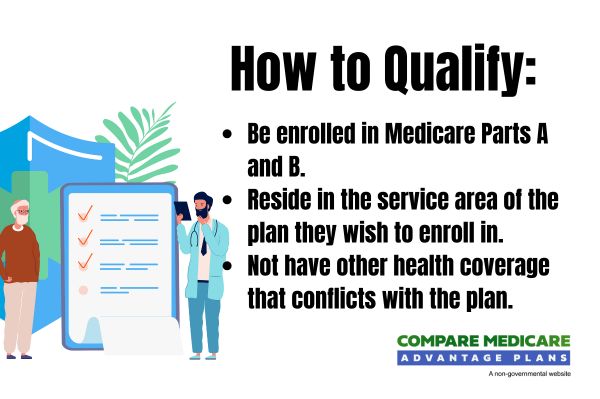
To qualify for Medicare Advantage Plans in South Dakota, individuals must meet specific criteria. Primarily, residents aged 65 and older, as well as younger individuals with certain disabilities, are eligible. Additionally, to enroll in a Medicare Advantage Plan, individuals must first be enrolled in Original Medicare (Parts A and B).
Eligibility also requires living within the service area of the plan you wish to join. Some plans, particularly Special Needs Plans (SNPs), may have additional eligibility conditions, such as requiring certain chronic conditions or dual eligibility for Medicare and Medicaid. Enrollment is typically restricted to certain periods, including the Initial Coverage Election Period and the Annual Election Period.
Contracted Network and Access to Care
Medicare Advantage Plans in South Dakota might limit enrollees to a contracted network of healthcare providers to manage costs and possibly ensure coordinated care. This network-centric approach might affect access to necessary services, as beneficiaries must use in-network providers for non-emergency care to receive full benefits. However, some plans do allow for out-of-network care, albeit at a higher cost.
Regulations require Medicare Advantage Plans to provide essential services outside their network at in-network cost-sharing rates if no suitable in-network options are available. This could help ensure that beneficiaries have access to necessary healthcare even when in-network providers are insufficient. The adequacy of a plan’s network will likely be crucial for ensuring that enrollees can access the care they need.
Comparing South Dakota Medicare Advantage Plans to Original Medicare
Some Medicare Advantage Plans might include additional benefits not typically covered by Original Medicare, such as dental, vision, and hearing care. These plans bundle the benefits of Medicare Parts A and B, and sometimes Part D as well, into a single plan. However, certain Medicare Advantage Plans may also charge a monthly premium alongside the standard Part B premium.
Accessing care through Medicare Advantage will likely require using network providers, unlike Original Medicare, which could allow more flexibility in choosing healthcare providers. Some plans, especially HMOs, might require members to choose a primary care physician and obtain referrals for specialist services. This contrasts with Original Medicare, where no referrals are necessary to see specialists.
Coverage Differences
Coverage differences between Medicare Advantage Plans and Original Medicare could be significant. HMO plans typically require members to use a network of doctors and hospitals for covered services, whereas PPO plans provide more flexibility, allowing visits to out-of-network providers at higher costs. Special Needs Plans (SNPs) are tailored for individuals with specific health conditions and often have network restrictions similar to HMO plans, though some SNPs allow out-of-network access without referrals.
The need for referrals to see specialists varies by plan type; HMO members typically need them, whereas PPO and SNP members may not, depending on the specific plan.
Emergencies and Referrals

Some Medicare Advantage Plans might require referrals for specialist visits, unlike Original Medicare where referrals are not necessary. This means that beneficiaries need approval from their primary care physician before seeing a specialist, which may be an administrative barrier for some. However, addressing administrative barriers will likely ensure coordinated care and could potentially help manage healthcare costs.
For urgent care outside the U.S., some Medicare Advantage Plans may provide coverage, whereas Original Medicare typically does not cover such expenses. In-network providers may be required for non-emergency care in Medicare Advantage Plans, which could potentially limit provider choice compared to Original Medicare. This network requirement likely ensures that care is provided by trusted providers, but it may restrict flexibility for some beneficiaries.
Summary
Navigating the potential Medicare Advantage Plans in South Dakota might be complex, but understanding the types of plans available, the potential benefits, and the enrollment process can make a significant difference in choosing the right plan. From HMOs to PPOs and SNPs, each plan will likely offer unique benefits tailored to different healthcare needs. By considering various factors like the potential coverage, costs, and provider networks, beneficiaries will likely find a plan that meets their specific requirements. With the right information, South Dakota residents can make informed decisions and enjoy comprehensive healthcare coverage that enhances their quality of life.
Frequently Asked Questions
→ What are the main types of Medicare Advantage Plans available in South Dakota?
South Dakota’s Medicare Advantage Plans primarily include HMO, PPO, Private Fee-for-Service (PFFS), and Special Needs Plans (SNPs), each designed to meet various healthcare requirements.
→ When can I enroll in a Medicare Advantage Plan?
You can enroll in a Medicare Advantage Plan during your Initial Enrollment Period, which is three months before to three months after your 65th birthday. Additionally, you have opportunities during the General Enrollment Period from January 1 to March 31 and the Open Enrollment Period from October 15 to December 7.
→ What additional benefits could Medicare Advantage Plans offer compared to Original Medicare?
Some Medicare Advantage Plans may provide additional benefits that could go beyond Original Medicare, which might include dental, vision, and hearing care, as well as prescription drug coverage. These potential benefits could improve your overall healthcare experience.
→ How might the costs of Medicare Advantage Plans compare to Original Medicare?
Some Medicare Advantage Plans could potentially offer lower premiums and out-of-pocket costs compared to Original Medicare, possibly making them an appealing option for many beneficiaries. This potential affordability may provide greater financial relief for those needing healthcare coverage.
→ Do I need referrals to see specialists with Medicare Advantage Plans?
Yes, certain Medicare Advantage Plans may require referrals from a primary care physician to see specialists. It’s essential to review your specific plan’s rules to ensure compliance.

ZRN Health & Financial Services, LLC, a Texas limited liability company




